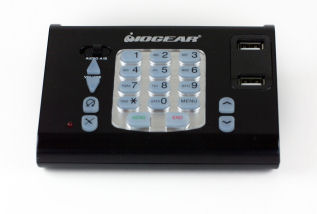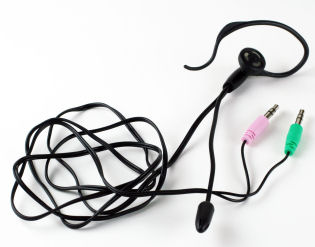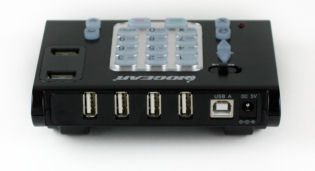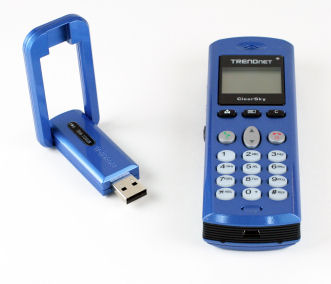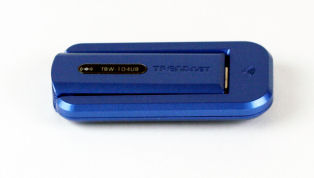Introduction
Skype has spawned an entire ecosystem of telephony, which includes plenty of hardware devices intended to enhance the experience. You can find just about any kind of phone product for Skype you might want, from speakerphones, to headsets and dialpads, to wireless handsets, and a whole lot more.
This review will look at two additions to the Skype hardware universe: Iogear’s USB VoIP Skype Calling Kit, and Trendnet’s ClearSky Bluetooth VoIP Kit.
Iogear USB VoIP Skype Calling Kit: The Pitch And Product
| Iogear USB VoIP Skype Calling Kit (GVI2065U) | |
|---|---|
| Summary | Combo device for Skype calling that includes a USB keypad with headset and functions as an active 6-port USB hub. |
| Update | 5/11/2006 – Added work-around for missing “+” key |
| Pros | • Easy to install and use • Good sound quality • Good Skype integration |
| Cons | • Current keypad doesn’t completely support SkypeOut dialing • External speakers require switching a jack or using another microphone |
So you’ve got a broadband Internet connection and want to start using it for phone calls? Iogear offers an interesting combination of capabilities in a compact package, which delivers most of the goods necessary to support a positive IP telephony experience based on eBay’s wildly popular Skype VoIP service.
The product is simply designated a Skype Calling Kit. It includes a dialpad and a headset, along with strong Windows compatibility and good Skype integration; this combination of features makes it easy to install and use. Figure 1 shows a front view of the dialpad with no cables installed, for an unobstructed view.
Figure 1: Iogear Skype Calling Kit Dialpad front view (click image to enlarge)
Iogear Kit, Continued
The dialpad is a compact USB device that attaches to any standard USB 1.1 or 2.0 port on a desktop or notebook computer. This device integrates audio connections for incoming and outgoing voice traffic with headset feedback. It also has plenty of connectors and controls, including six USB ports – two on the top right front and four more around the back – two sets of audio jacks, a telephone keypad and various control buttons.
An over-the-ear headset is included with the device, and is shown in Figure 2. Notice that the headset uses the two-plug computer-oriented headset style, compared to the single-jack style popular on cell phones. One plug connects to a single over-the-ear speaker bud – the ear clip pops off easily and only needs to be reversed and replaced to switch from left ear to right – and the other is for the microphone at the end of the small wire boom.
Figure 2: Iogear Skype Calling Kit headset (click image to enlarge)
A small 5V 2.5 amp AC-to-DC power converter is also included with the unit to power the dialpad. It is only needed, however, if you plan to use additional USB devices that require power through their USB ports. A rear view of the dialpad (see Figure 3) shows the power port, a USB Type B port for the PC link, and four extra standard USB ports for other devices.
Figure 3: Iogear Skype Calling Kit Dialpad rear view (click image to enlarge)
Iogear – Test And Verdict
This product is a good one in most of the aspects that matter. It’s incredibly easy to install and use, as long as you follow the instructions on the driver CD’s readme file. In particular, make sure to install the most current version of Skype before installing the drivers, and set up the drivers before plugging the device into your PC. The whole process took less than two minutes to complete – primarily because we already had the most current version of Skype – and worked without a hitch.
Once setup was done, we were immediately able to start using the headset and dialpad to place and receive Skype calls. Incoming sound quality was quite good, on par with that of the Plantronics Persono D200 headset we normally use. Those who took our test calls reported equally good sound quality on their ends. In fact, as long as you stay in-network on Skype, you’ll find the calling kit to be a great tool and a definite productivity enhancer.
Update 5/11/2006 One minor issue is that the keypad is missing the “+” key that you need to start a SkypeOut dial string. I initially worked around this by jumping over to my regular keyboard to enter the “+”, after checking with Iogear to see if they had a work-around (they didn’t). But a helpful reader pointed out that entering a double zero “00” will also do the trick. So now I’m the wiser and so is Iogear!
The number pad is great other than that omission, and because it’s laid out just like the keys on an ordinary telephone dialpad, it feels pretty familiar. But alas, its keys are stiff and require real effort to depress, which resulted in dropped numbers when we didn’t watch the screen to make sure all the digits actually “took.” The other controls work well, and the dialpad layout and functions are sensible.
The other gotcha we discovered with this product became obvious when we tested its speakerphone capabilities. If you want to use external speakers through the dialpad itself, you must either switch the microphone jack for your headset around to the other side of the unit when you make the audio A/B switch, or you must use a separate microphone to pick up your own voice input. Iogear might have considered designing this unit to permit speaker and microphone changes to occur independently.
That way, for example, you could keep the headset on and play incoming audio through the loudspeakers, while continuing to use the microphone on the headset to speak. This is actually a minor nit, however, because you can easily configure Skype to play audio through the external speakers, while also using the microphone on the headset for audio input, as the screenshot in Figure 4 clearly illustrates.
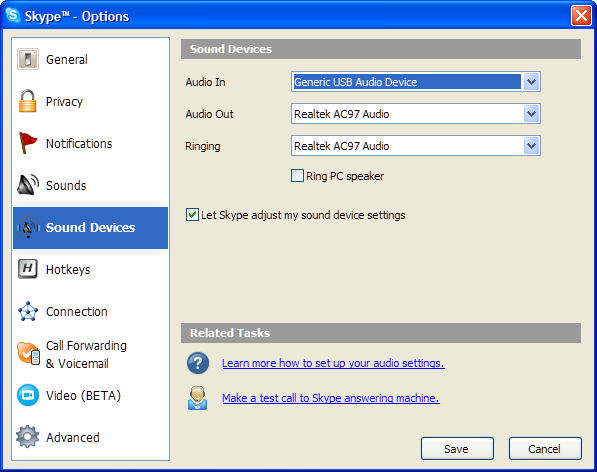
Figure 4: To use the headset mike and external speakers inside Skype, pick Generic USB Audio Device for Audio In, and your external speaker device for Audio Out
As a USB hub, the dialpad also performed well. We tried it with a USB flash drive and a CompactFlash card reader, and it worked the same as if we’d hooked those devices right up to our PCs. We didn’t notice any degradation in sound quality for Skype calls, even when simultaneously transferring large files to our high speed (120x) Memina Rocket drive.
With a street price of $55-60, this package costs about as much as our Plantronics headset. While it lacks that unit’s stereo sound and hi-fi capabilities, it is about equal in the area of telephone voice quality, and you get extra USB ports thrown in at no extra charge. For regular Skype users, this one’s definitely worth considering, and perhaps buying!
Trendnet ClearSky Bluetooth VoIP Kit: The Pitch And Product
| Trendnet ClearSky BlueTooth VoIP Kit (TVP-SP1BK) | |
|---|---|
| Summary | Small, boxy wireless handset plus USB Bluetooth receiver. |
| Update | None |
| Pros | • Easy to install and use • Good Skype integration with software |
| Cons | • Poor mobility support: no headset included, no belt clip • Sometimes spotty sound quality; subject to interference • Limited functionality handset |
If you have a broadband Internet link, a desire for VoIP communications, and a need to move around rather than stay rooted at your desk, a wireless VoIP handset seems like a natural fit. But not all wireless handsets are created equal, as we learned when using the Trendnet ClearSky device.
This product bundle consists two devices. The first is a small, light and boxy little metallic blue handset; its dimensions are 5.6″ x 1.78″ x 0.9″ (143.5 x 45 x 22 mm) and it weighs 3.5 oz (100 g). The second is a Bluetooth USB dongle that looks very much like a flash drive. Both are illustrated in Figure 5.
Figure 5: Trendnet handset and USB dongle (click image to enlarge)
One nice thing about the dongle’s design is that it includes a built-in cover that rotates around to protect the business end of the device. Like the best of the flash drives it resembles, this device makes the cover an integral part of the package, rather than providing a cap or cover that can be too easily lost when it’s removed. Figure 6 shows the dongle folded up, with the cover doing its intended job.
Figure 6: Trendnet handset and USB dongle (click image to enlarge)
Trendnet – Test And Verdict
We found the software for the ClearSky handset easy to install and use. As with the Iogear setup, we had to first install Skype on our test machine, then install the drivers, and finally plug the handset in to charge it. Once charged up and powered on, it found its Bluetooth receiver immediately, and we were able to begin making and receiving calls within the Skype interface. When placing and listening to the Skype test message that’s a part of routine set-up, we initially encountered terrible problems with signal quality, but were soon able to remedy that situation and begin using the device in earnest.
There is one interesting thing about the ClearSky handset that may be of particular interest to notebook PC users: the device charges through a USB cable, not from a wall socket adapter. This means that as long as your notebook has sufficient spare juice to power up the handset’s 3.7 V 700mA battery – and most notebook batteries will – you can stay connected for as long as your notebook does.
We followed the vendor’s recommendations and let the battery charge from a desktop PC for six hours before using the handset. Nevertheless, we found that talk time didn’t extend much past four hours, rather than the six hours promised in the vendor literature. Even so, battery life shouldn’t be a problem for this unit. (We didn’t test the 60 hour standby power claim.)
The handset communicated well with the Bluetooth dongle anywhere inside our test building, except when we got close to anything with a transformer. The unit also worked equally well through a Bluetooth receiver we had set up for a Dell Axim x51v. Because our test machine used a CRT, we quickly learned that installing a two-foot USB extension cable would remedy the overwhelming hum that the dongle otherwise picked up from that display’s transformer.
As we walked around the building, we also noticed a similar but less powerful hum any time we got within 10 feet of a fluorescent light. Walking down the street from the building, we maintained clear voice communications up to about almost 100 feet (30 meters) away; transmissions dropped out altogether at 165 feet (50 meters). Though this doesn’t match the 330 feet (100 m) promised in the vendor literature, that claim also indicates that actual distance will vary depending on the environment in which it’s used. In any case, even 100 feet is plenty for most users who want a phone to keep working as they wander or work away from their desks within the confines of a small building.
Figure 7 shows a close-up of the handset display, which provides resolution of 96×64 pixels for four lines of text display, including control icons. The display uses dark characters on a light background, and is quite clear in office lighting or daylight situations, but showed the occasional tendency to blur just a little. In dark environments, the display is backlit only when dialing a number or managing the handset’s controls, which should likewise be sufficient for the needs of most users.
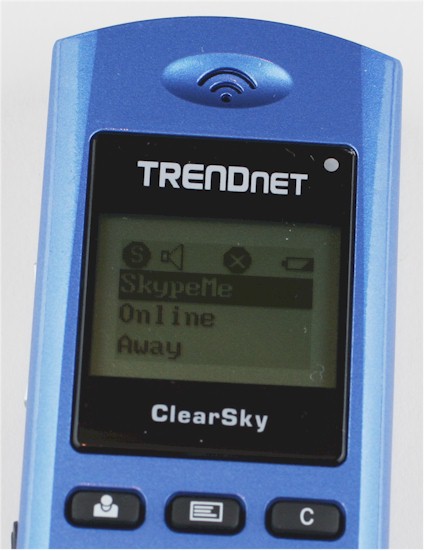
Figure 7: Trendnet handset display
Trendnet – Test And Verdict, Continued
As we reached the limits of the signaling range of the handset, signal quality began to fade, and we observed various types of noise. Some of it sounded like typical interference or signal degradation, but as distances increased we also picked up what sounded like crosstalk. Ordinary wireless phones also operate at that frequency range, so those were probably starting to bleed into our reception as the Bluetooth dongle strained to pick up a clear signal. Of course, it’s always possible that other Bluetooth voice devices were also in use in our neighborhood.
In working with the handset, except for occasional issues with signal strength or interference that diminished voice quality, the ClearSky device worked well; calls were audible and intelligible. Though sound quality wasn’t as good as on the Iogear unit, that’s to be expected with a small, low-powered wireless device like this one. Volume controls were easy to use and adjust, and we had no trouble hearing calls at the default settings.
Unfortunately, the handset leaves something to be desired in terms of Skype integration. While you can check SkypeOut credit levels from the phone, your ability to interact with Skype itself from the phone is more limited than you might think. If the idea behind a wireless handset is to let users leave their desks, it would stand to reason that the handset would permit its users to navigate around inside the Skype interface. As long as Skype IDs or phone numbers are present in history records, you can access them through the handset. But if you want to search for somebody’s Skype ID, add or edit a Skype contact entry, or access Skype voicemail, you must return to your PC.
In terms of look and feel, the handset resembles a late 90s cellphone, before the days of small clamshells with integrated digital cameras and color displays. The ClearSky handset certainly wins no design prizes, being rather plain and boxy. Its all-plastic construction also feels a little flimsy in the hand, though it stood up well to a week’s worth of casual use during testing.
The unit supports only four distinct ringtones, including no plain-vanilla bell ring. Neither the ringtones themselves nor the ringtone volume can be changed on the unit, either. And while it incorporates a 2.5 mm cellphone headset jack, the vendor didn’t see fit to include even a cheap earbud with the unit; nor did they provide a belt clip or holster to make it easy to carry the handset on your person instead of in your hand.
At a street price in the $85 to $90 range, this unit offers decent functionality for a pretty reasonable price. But conventional wireless handsets cost about the same, and cellular phones go for even lower prices as long as you sign up for a calling plan. Thus, you should buy this unit only if Skype is your primary calling tool, and if you need modest but workable mobility.

